Interproximal reduction (IPR) / Teeth stripping (shaving, filing). –

Stripping teeth creates room for realigning them.
What is teeth stripping / interproximal reduction?
“Stripping” (teeth shaving or filing) refers to a procedure where your dentist trims a small thickness of tooth enamel from the sides of selected teeth (at that point where they would normally touch against each other if in regular alignment).
What is accomplished?
The purpose of this procedure is to narrow the width of the teeth, so there is available space in which to orthodontically realign them.
Other terms.
Equivalent terms used to refer to this process include teeth shaving, interdental reduction, interproximal reduction (IPR), and, most precisely, interproximal enamel reduction.
With this last term, the word enamel is included in the phrase as an indication that the trimming is confined to just the enamel layer of a tooth. As we explain below on this page, this is an important stipulation for this procedure.
We’ve subdivided our coverage of this subject into the following topics.
- Applications for IPR. – Types of cases it’s used for.
- How much of the tooth is trimmed? – Rules of thumb and guidelines.
- Does shaving a tooth harm it? – Risks and side effects.
- The procedure. – How a dentist strips teeth. / Does it hurt?
- Are there any alternatives to stripping/shaving teeth?
When is interproximal reduction technique used?
There are a number of applications where just slicing a minute portion of several individual teeth off can cumulatively provide all of the room that’s needed for a person’s planned orthodontic work.
Your dentist should be able to tell you if they expect that IPR will be needed before your treatment is begun.
Applications for teeth shaving.
a) Correction of tooth crowding.
Probably the most-used application for IPR is the obvious one. It’s used as a part of the treatment plan in correcting cases involving tooth-crowding issues (crooked and otherwise misaligned teeth).
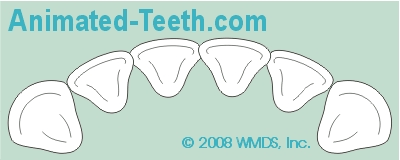
The teeth are first stripped (narrowed), then realigned.
The plan.
Then, some type of orthodontic appliance (conventional braces, Invisalign® aligner, etc…) is used to reposition and correct the alignment of the teeth. (See animation.)
Types of cases.
- When tooth stripping can provide enough space, it might be used with a person’s initial/original orthodontic treatment.
- This technique is often ideally suited for correcting orthodontic relapse Major/minor case failure. that has occurred with a patient’s lower front teeth following their original treatment. (Like when a person has not worn their retainers as directed.)
b) Tooth size and teeth length discrepancies.
The corresponding teeth on a person’s left and right sides are usually mirrored images of each other. In cases where they’re not, the size discrepancy that exists between matching tooth pairs can interfere with producing an acceptable treatment outcome.
Additionally, the combined length of a person’s upper and lower teeth must be of comparable proportions. If one is substantially larger than the other, producing an acceptable orthodontic outcome may not be possible.
Using interproximal reduction to file down the width of individual teeth to more normal and expected dimensions can resolve these issues.
c) Black triangle reduction.
Due to the (normal, natural) shape of their teeth, some people’s smiles show “black triangles” (spaces between their teeth that are not filled with gum tissue). This appearance is often caused by or amplified by gum recession that has occurred.
By filing down and flattening out the contact point of the teeth and then realigning them, these spaces can be closed in to some degree.
d) An aid in making other alignment improvements.
Interproximal reduction can sometimes be used with treatment plans that attempt to camouflage (not fully correcting but only improving the appearance of) some dental abnormalities. Although, using this type of approach isn’t always appropriate.
a) Overjet correction.
Overjet refers to the situation where a person’s upper teeth protrude forward (their lower teeth occupy a position some distance to the rear of the uppers). With some cases, tooth shaving might be used to narrow the width of the upper teeth, so they can be pulled back into a more normal-looking alignment.
b) Proclined incisors.
▲ Section references – Noar, English
How much of a tooth is trimmed away?
The precise amount that’s sliced off will vary according to the specifics of the patient’s case. (As you’ll learn below, that’s a prime advantage of using IPR. Only the actual amount of space that’s needed is created.)
General rules that apply to the amount of interproximal reduction that’s possible.
- To avoid harming a tooth, the amount that’s sliced off is never greater than the thickness of its enamel covering. (A dentist can get an idea of this thickness from x-rays that have been taken.) And preferably, on the order of no more than about 50%. (Pindoria)
- For front teeth, even small lower ones, it’s usually possible to remove on the order of 0.3 mm, possibly more, from each side of a tooth. For back teeth, this number can usually be 0.6 mm or more. (Proffit, English)
(As a point of comparison, a credit card is usually just slightly less than 0.8 mm in thickness. So, the amount shaved off between two touching teeth is right about this same amount.)
- Of course, it’s the cumulative amount of space that can be generated that’s important. So generally, IPR technique is considered a viable option for tooth-crowding cases that require 8mm or less of additional space (generally categorized as mild to moderate tooth crowding) (Pindoria).
More commonly, this technique is utilized with cases requiring only 1 to 5 mm of additional space. (Like the case of mildly irregular lower incisors.) (English)
- The idea of tooth stripping isn’t usually considered until all of the teeth involved have erupted and can be evaluated collectively. (Proffit)
▲ Section references – English, Proffit, Pindoria
Risks, side effects, and concerns associated with IPR.
You might be concerned that your dentist plans to shave off a portion of your misaligned but otherwise healthy teeth.
As you’ll find explained in this section, that’s not usually a concern. And, actually, when compared to other options it’s often easy to see why filing off a little bit of tooth enamel frequently makes the better, more conservative, choice.
Does stripping your teeth damage them?
Obviously, when interproximal reduction is performed, some thickness of the tooth’s enamel is lost. The question then becomes, does shaving off this amount of enamel damage a tooth?
a) IPR approximates normal (acceptable) wear.
As an explanation for why it’s OK to strip teeth, the idea is that the amount filed off (ideally no more than about 1/2 the thickness of enamel that exists) is on the order of the amount of wear evolution has prepared our teeth to accommodate.
Background.
- Every tooth is anchored in your jawbone by a ligament. And this ligament allows for small amounts of tooth movement.
- As movement takes place continuously over time, like when we eat or clench our teeth, some tooth-to-tooth wear occurs. And in fact, it’s normal for the contact points of teeth to wear flatter as we age.
- This effect was especially noticeable in primitive humans who had a coarse diet. In comparison, modern humans typically maintain a comparatively much softer diet and therefore experience much less interproximal wear.
- As a result, the enamel covering of teeth is much thicker than is expected to ever wear away naturally over a person’s lifetime. And therefore some of this enamel can be sacrificed (shaved away) without resulting in tooth harm.
▲ Section references – English
b) Are stripped teeth more likely to experience problems or side effects?
Interproximal reduction technique has been used by orthodontists for decades. And over the years, many dental researchers have evaluated its long-term effects in search of associated risks and problem issues.
Concerns include the potential for increased levels of tooth decay, problems in maintaining periodontal (surrounding gum and bone) health, pulpal (nerve tissue) irritation or damage, and increased thermal (hot/cold) sensitivity.
Research findings.
A study by Zachrisson found no increased incidence of side effects (tooth decay, periodontal or pulpal problems) in a group of subjects that had had tooth stripping performed more than ten years previously.
However, 2 of the 61 subjects did report having thermal sensitivity. Although, this is a multifaceted complication and couldn’t be conclusively attributed to the teeth having been shaved.
▲ Section references – Zachrisson
A unique benefit of interproximal reduction.
The way the contact points between teeth are shaved down with IPR and therefore are less rounded and flatter helps to aid in the inherent stability of the patient’s teeth as a unit.
▲ Section references – Proffit

Teeth can be filed using either a dental drill or an abrasive strip.
Interproximal enamel reduction – How is it performed.
What tools are used?
- Mechanical methods – Using a dental drill, teeth are trimmed using a spinning diamond-coated bur or disk.
- By hand – Diamond coated abrasive strips are worked back and forth in a sawing motion between the teeth.
The method that’s chosen will most likely depend on how much tooth structure needs to be sliced off.
If it’s just a very small amount, the dentist will probably work by hand because that method gives them the most control over how much enamel is shaved away. For larger reductions, they’ll probably use their dental drill.
The steps of the IPR procedure.
The trimming process is pretty much as easy as you might imagine. The dentist simply uses their chosen tool(s) (drill and/or abrasive strips) and incrementally files down and slices away small amounts of each tooth’s enamel until the needed amount of reduction has been accomplished.
a) Specifics about the trimming process.
- Since the filing is entirely confined to a tooth’s enamel covering (a layer that has no association with its nerve tissue inside), an anesthetic is not usually administered.
- If the teeth being trimmed are especially crooked, the dentist may “separate” the teeth so they have less obstructed access.
To do so, they’ll place some type of wedging device (wooden wedge, wedging clamp, etc…) in between the teeth that just pushes them slightly out of contact.
- It’s paramount that the dentist doesn’t heat a tooth excessively as they trim it. Especially when using a drill for this process, air or water spray will be applied to the tooth to keep it cool.
b) Your dentist will take care not to trim too much.
From time to time during the stripping process, your dentist will stop and fit a small thickness gauge (leaf gauge or dental probe) between your teeth and measure the gap they’ve created so far.
Once they’ve widened the gap enough, they’ll document this width in your dental chart. Any future stripping will be documented too, so no tooth has too much enamel removed.
c) Polishing the trimmed surfaces.
Once the needed amount of tooth reduction has been accomplished, the dentist will polish each tooth’s filed surfaces so they are as smooth as possible.
This might be accomplished via the use of a strip or bur, disk, or wheel placed in a dental handpiece. But this time the instrument used will have a much finer grit.
d) Protective measures for the shaved surfaces.
▲ Section references – Noar, Pindoria, Zachrisson
What’s it feel like when interdental reduction is performed?
Does it hurt?
Don’t worry, having your teeth shaved isn’t that big of a deal and shouldn’t hurt at all.
As stated above, the portion of your tooth that’s being sliced down is 100% enamel. And since a tooth’s enamel covering has no association with its nerve tissue inside, no pain should be felt (no dental anesthetic should be required).
What will you notice?
It’s expected that you’ll feel the tug of the diamond strip between your teeth or the vibration of the drill as it does its work. If some type of wedging device has been placed, you’ll feel the minor amount of pressure it creates too. But generally, the whole process should just be a minor event.

After IPR.
After they’ve been stripped, will you notice gaps between your teeth?
Timing of the IPR procedure.
How many times/how frequently will your teeth need to be shaved down?
a) Interproximal reduction as a part of the Invisalign® treatment process.
Due to advances with the Invisalign® system’s software, the timing of case IPR has evolved.
Historically.
When the Invisalign® system was first introduced, there was a need to perform a case’s needed tooth shaving before the patient’s aligners were fabricated.
However, having to perform IPR before any tooth movement had been accomplished often left the dentist with a difficult task. If their patient’s teeth were especially overlapped, performing the trimming without damaging adjacent teeth could be difficult.
Nowadays.
b) IPR with conventional braces.
As opposed to the situation where the dentist’s treatment actions must conform to the shape/design of their patient’s previously fabricated Invisalign® aligners, with conventional braces the dentist can perform tooth stripping at any point during the treatment process.
▲ Section references – English
Additional orthodontic methods – Possible alternatives to IPR.
Tooth filing/shaving is just one method that an orthodontist can use to gain the space they need to realign their patient’s teeth. Alternatives do exist and the following animations show how they are used.
a) Tooth extraction. / “Extraction” cases.
A common way of gaining space for orthodontic purposes is to remove selected teeth. These are referred to as “extraction” orthodontic cases.
A common plan is to remove a pair of teeth (the same one on each side, premolars are common) so the patient’s dentition remains bilaterally symmetrical. Their remaining teeth are then realigned so they are both straighter and fill in the missing teeth’s spaces.
As for disadvantages of this technique:
- The patient is subjected to having a surgical procedure.
- Philosophically, this approach strays from the ideal somewhat in the sense that a healthy tooth is sacrificed for strictly cosmetic purposes.
- There’s also the issue that there’s no such thing as removing 1/2 of a tooth. The orthodontist always gains a whole tooth’s width, whether the patient’s case requires that much space or not.
(In comparison, with tooth stripping, very small, precise amounts of needed space can be created.)
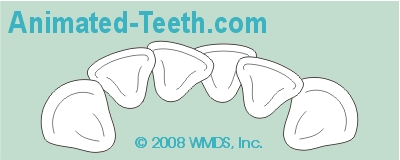
The space needed to realign teeth is sometimes created by extracting teeth.
An example involving front teeth.
And yes, the patient will end up only having three lower incisors but the vast majority of people who see their smile will never notice that anomaly.
b) Teeth flaring. / “Expansion” cases.
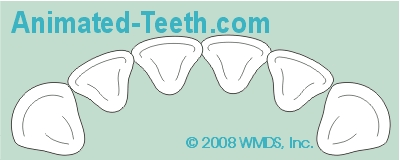
Crowded teeth can be realigned by expanding the dental arch.
▲ Section references – Proffit
Don’t think that all cases require additional orthodontic space.
IPR is only used to create space into which a person’s crooked teeth are then realigned. So, if additional space is not needed to accomplish the kind of correction your case requires, this procedure or any of the others just described will not be needed.
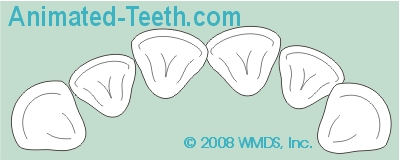
Realigning rotated teeth may not require tooth stripping.
a) Cases involving rotated teeth may not require teeth reduction/shaving.
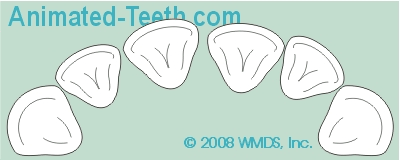
No additional space is needed when closing tooth gaps.
b) Closing spaces between teeth.
Page references sources:
Boyd RL. Esthetic Orthodontic Treatment Using the Invisalign Appliance for Moderate to Complex Malocclusions.
English JD, et al. Mosby’s Orthodontic Review. Chapter: The Invisalign system.
Noar JH, et al. The Ethics of Interproximal Reduction.
Pindoria J, et al. Inter-proximal enamel reduction in contemporary orthodontics.
Proffit WR, et al. Contemporary Orthodontics. Chapter: Retention.
Zachrisson B, et al. Dental health assessed more than 10 years after interproximal enamel reduction of mandibular anterior teeth.
All reference sources for topic Straightening Teeth.